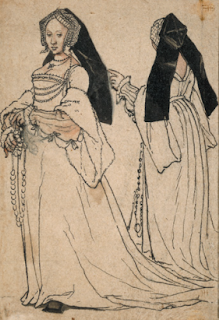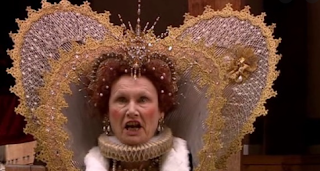What's in your Wardrobe?
The clothes that ordinary Tudor women wore.
As part of my research for "Woodsmoke and Sage", my forthcoming book, I delved into the question of clothing; how it was made, what it looked, felt and smelled like, how it differed among the classes, and where women got their clothes from.
Tudor clothing could be really expensive, with yards of some materials costing the equivalent of a sheep or cow, upon which an entire family might depend for milk, butter, cheese and cream, or even wool and meat. In Elizabeth's reign, young courtiers frequently got into trouble for selling their family estates and heirlooms in order to keep up with fashion. There were rules in place restricting what you could wear according to your class, called the Sumptuary Laws, but as these were regularly reissued throughout the sixteenth century, it suggests they were not strictly followed. The Tudors were peacocks and loved to dress up.
Much information exists about what the upper classes wore, through their wardrobe accounts, inventories and portraits. They might be visited by tailors or select yards of cloth from a merchant, upon which their seamstresses would go to work. A small army of men and women worked at court to ensure that the clothing of the royal family was suitably embroidered and decorated with Venice lace or gold spangles, mottoes or Tudor heraldic devices. When it comes to the lower classes, though, clothing was less about status and more concerned with functionality; keeping warm and allowing for the physical work in which women engaged, in domestic and agricultural settings. Their garments were often homespun, or hand-me-downs, from friends and family, adapted and patched, or bequeathed in wills. It is in the wills of sixteenth century women that we learn about their clothes, particularly widows and spinsters, as married women were not legally permitted to make bequests. All their possessions, bar a few necessaries, belonged to their husbands.
Here, by reading the last testaments of widows living in sixteenth century Oxfordshire and London, we can open the wardrobes of five different women and view the contents:
Margaret Mablestone of Merton, 1555
The twice-married Margaret had two daughters, two sons and seven grandchildren. She was comfortably off, with her effects valued at £13. Her wardrobe contained seven kerchiefs, or fabric squares to cover the head, like a modern bandana, a best gown, kirtles or outer gowns in violet, worsted and serge, a best petticoat, a second best petticoat and two old ones.
Ursula Andrews of Woodstock, 1558
The widowed Ursula had some choice items in her possession, a best frock of cloth and a second best cloth, a damask kirtle, a worsted kirtle and a worsted cloak. She owned a new French hood, which she left to her granddaughter, two brooches and a gold ring with a seal, to allow her to stamp her personal device into the wax of letters and documents. She instructed that the remainder of her clothing be distributed among the poor.
Johane Wynterbourne of Brook Grove, 1574
Johane was the widow of a sheep and barley farmer, and those items feature prominently in her will before she moves on to bequeathing personal items. She owned three kerchiefs and a cowl, or hood, and three petticoats, one with a bodice, one was her "worst" and the last one, her "best" was described as the one she was wearing. This raises the question of whether she was wearing this petticoat at the time of her death. If she was dictating her will in bed, ill, she may not have been dressed again, but had her clothing removed posthumously, which puts quite another spin on this bequest! Johane also owned a russet frock and a second frock, beads, silver and gold rings.
Julian (then a female name) Calcot, widow of a sheep farmer of Hook Norton, 1580
Julian's clothing suggest she dressed primarily for work and was actively engaged upon her sheep farm. She owned eight aprons, a smock and seven kerchiefs, but also some more dressy items, including a violet coat, two red petticoats and a russet petticoat. Dark, intense colours like these were expensive and desirable at the time.
Agnes Saunders of Stepney, 1588
As the widow of a knight, Agnes was undoubtedly the wealthiest of these women, as the extent of her wardrobe shows. She owned six and a half yards of unused cloth of gold, presumably intended for a future garment, and gave instructions that her gowns, kirtles and foreparts or velvet and silk be distributed among her three daughters. Her hoods, muffles, cornets, night-rails, bongraces and cornets (mostly accessories for the head and hands) were to be shared among her female servants. She left her gentlewoman and chambermaid each one of her best petticoats and a black gown to her niece. Funds were left in order to supply 40 poor women each with a gown, and black gowns each for the women in the almshouse. In addition, Agnes had a considerable amount of expensive jewelry, at least 6 gold bracelets, two of which were set with lockets, a gold chain, a gold crucifix with pearls, a clock watch and four gold rings, set with a variety of precious stones.
These wills show a degree of variety among the amount of items women possessed, although the basic elements of petticoats, gowns, kirtles and kerchiefs were universal. Women owned far fewer items of clothing and probably changed less often, but because they wore a number of layers, only their linen undergarments would have been close to the skin and therefore required washing more often. It is touching to see the personal items and preferences of these women, for their favourite pieces, which were often passed down to their daughter or granddaughter.
Read more about Tudor clothing and its significance in "Woodsmoke and Sage," coming in August:









Comments
Post a Comment